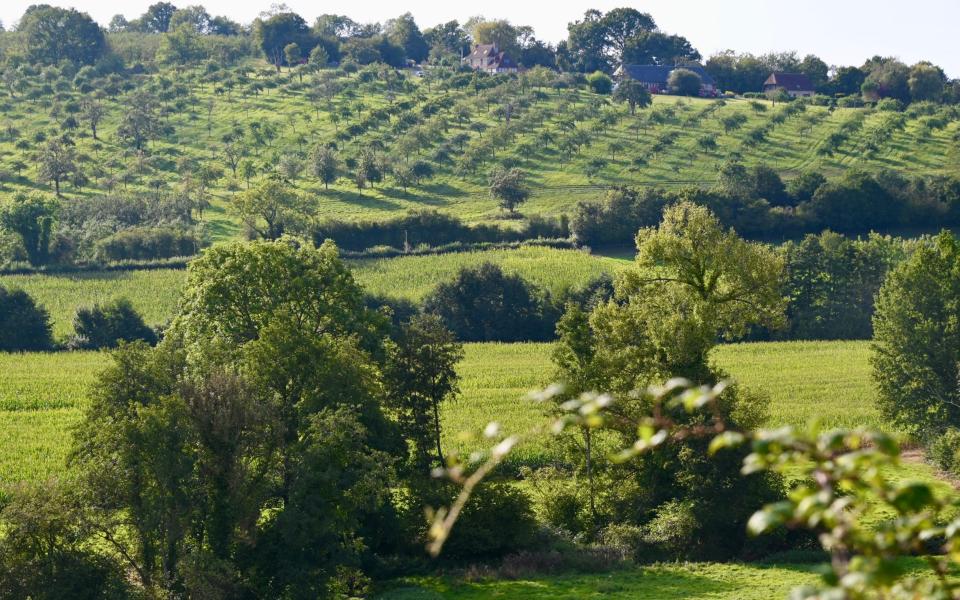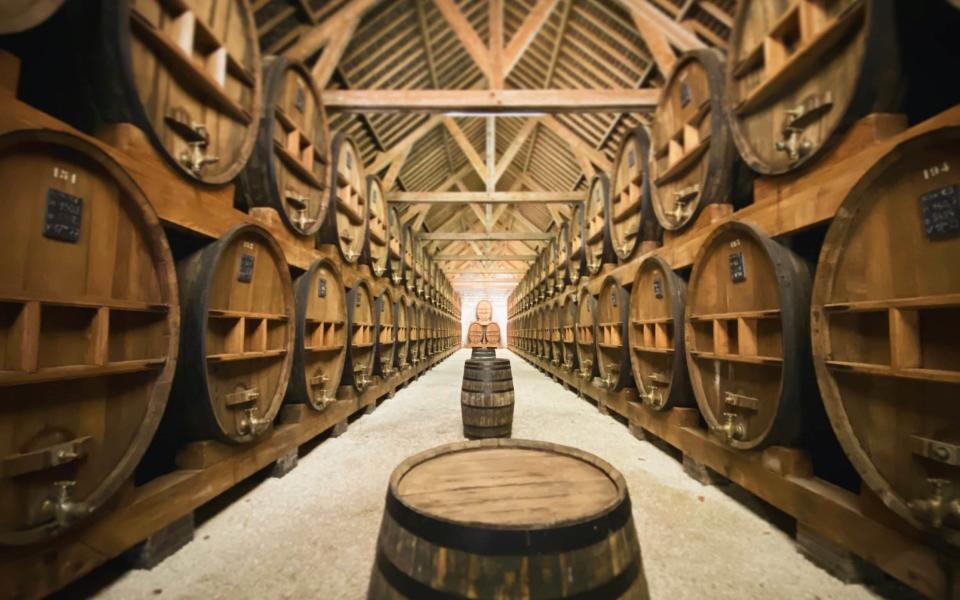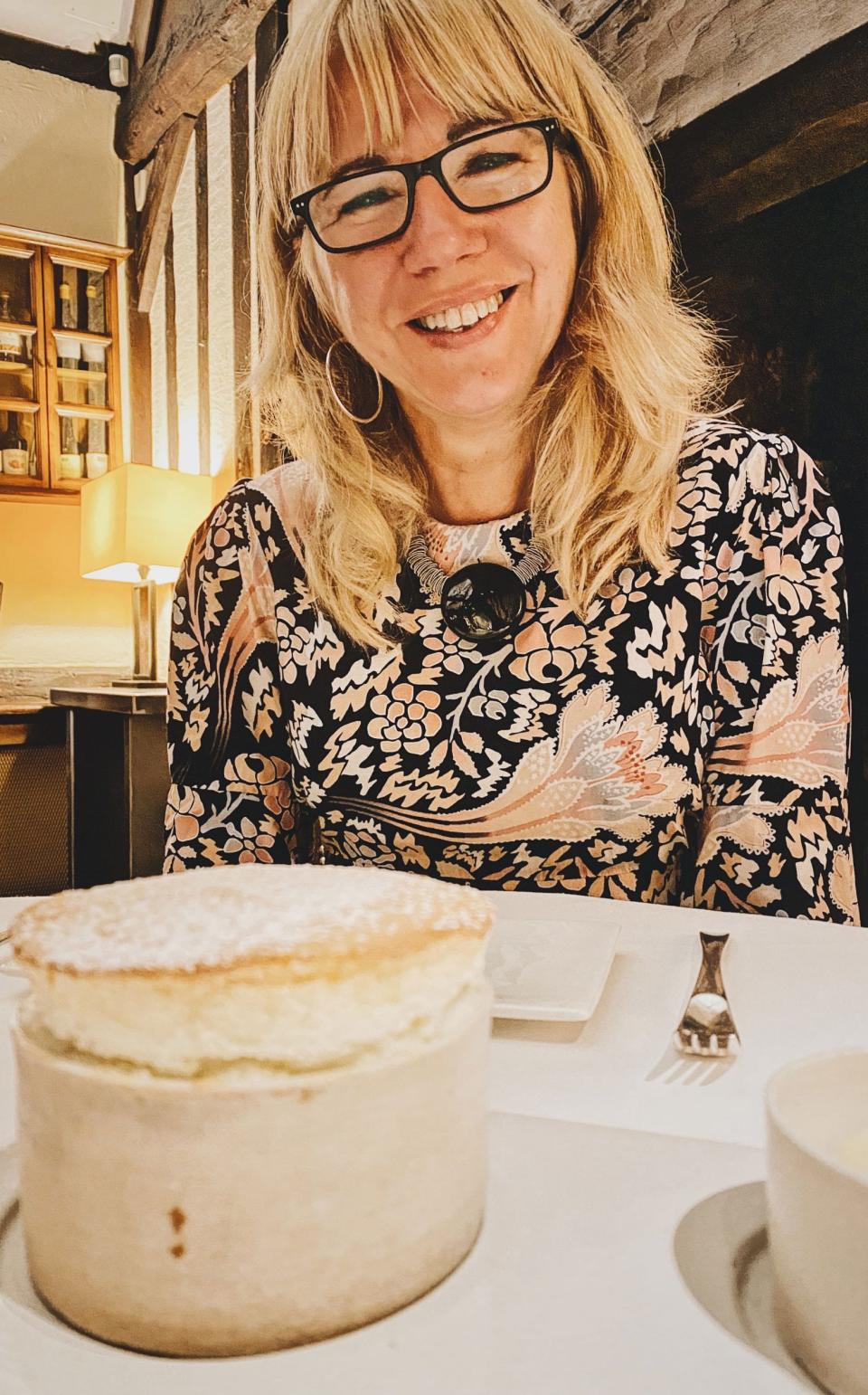In autumnal Normandy, all roads lead to food and drink

La route du fromage, la route du cidre, la route du poiré. In Normandy, it seems, all roads lead to somewhere lovely to eat and drink.
As summer drifted into autumn, those roads wound past apple and pear orchards ready to be harvested. Normandy cows munched on sweet grass, fertilising those orchards and preparing the raw materials for rich butter and cheese. Although there was still a hint of summer in the air, morning mists were filling the hollows between hills: it was time to embrace autumn and all its flavours. And, in honour of last week’s World Calvados Day, this was the place for it.
After rolling off the overnight ferry in St-Malo, I followed the well-worn pilgrims’ trail to Mont-St-Michel. Having this magnificent medieval abbey in my sights for the 40-minute walk from the carpark was one of the chief pleasures of this tidal island.
Another was to be the famously fluffy omelette at La Mère Poulard. But this pillowy concoction was criminally under-seasoned and, at €32 (£27), overpriced. I suspected that Mme Poulard’s heyday was some time ago.
As it happened, this was the only dud on my week-long dining – and drinking – road trip. That evening’s dinner at Au Plaisir de la Lucerne in the tiny Manche village of La Lucerne d’Outremer (staying at Les Châteaux de la Lucerne d’Outremer, from £150) made up for the lacklustre lunch. Energetic young couple Marine and Yoann were doing exciting things at low prices (two courses for €20/£17), especially the goat cheese panna cotta with cumin, carrot and prosciutto.

Before plunging into cider and poiré (perry) country in the southern Manche and Orne departments, I made a detour to the coastal resort of Granville. A stroll around its fortified upper town and seafront promenade up to Christian Dior’s old house, now a museum, whetted my appetite for a longer return visit. In the meantime, a louche afternoon in the lushness of the Normandy countryside awaited.
Pierre-Martin Neuhaus left his finance job in New York City in 2014 to become the third generation to run Distillerie du Coquerel, which produces practically every liquid that can be extracted from apples and pears: cider, calvados, pommeau (calvados with apple juice), poiré – plus Pierre-Martin’s own Normindia gin, which has a zingy citrus flavour inspired by his time in India.
“Calvados is probably the most sustainable spirit in the world,” he said. “Irrigation is prohibited in Normandy, so it’s naturally made by the landscape, and that way we don’t need to use water. We don’t use pesticides.”
He has been working with the British-French producers of Avallen, a bee-friendly calvados that formed part of an enjoyably lengthy tasting. All the complexities of apples came out in the drinks, from the pommeau’s sweetness and the young Avallen’s freshness to aged calvados that was almost like whisky.
Feeling light-headed and pleased I wasn’t driving, I went from the darkness of the tasting room to golden, late afternoon light filling the grounds of the Musée du Poiré near Barenton. Most of this free museum is outdoors, with educational trails showing how perry and cider are made. It set me up nicely for my visit the following morning to Ferme de l’Yonnière along the route du poiré, in the fertile countryside around medieval Domfront (staying at B&B Numéro 5, from €80).
Fourth-generation farmer Jérôme Forget not only produces perry and cider, but he also farms beef and dairy cattle. He doesn’t use pesticides either, relying on the hedgerows’ protective ecosystem around the orchards, his grazing cows fertilising the land. Feeling a bit decadent having a tasting at 10am, I sipped the pleasingly sharp Vinot poiré and the smooth, velvety Fossey. “The Fossey is almost 90 per cent sold before it’s even bottled,” he told me, which didn’t surprise me. The effervescent Champ du Poirier was delicious, rather like a crémant.

It was a suitable aperitif for a lunch of extraordinary, creamy langoustine soup with pollock medallions at Ô Gayot in the attractive spa town of Bagnoles-sur-Orne. And, that evening, smoked salmon with smoked aubergine at the Hostellerie de la Renaissance (from €101) in Argentan made me forget that overhyped omelette.
My meanderings through the Orne countryside, including another cider tasting in the bucolic Manoir de Durcet, soon led me to the first of the holy trinity of Norman cheeses – camembert. There’s not much to the village of Camembert itself, apart from a Camembert museum and tourist information point run by the Président food corporation, as well as a boutique and bar. But 10 minutes away in the pleasant town of Vimoutiers was the Musée du Camembert, which, though small, told the story of how the cheese was apparently invented by 18th-century cheesemaker Marie Harel. And it offered a tasting of camembert, pont l’évêque and livarot, three of the most fantastically pungent cheeses in France. You can smell the farmyard at 100 paces.
By now I had crossed into the Calvados department and Pays d’Auge, the region that comes to mind when we think of Normandy’s lusciously green landscapes and half-timbered villages. There I followed the route du cidre, which took me to Calvados Roger Groult, where Jean-Roger Groult is the fifth generation of distillers. He focuses solely on top-quality calvados, and his family history is worthy of a movie.
Also flying the flag for keeping a long family tradition going is Domaine Dupont. By this point I had tried every apple drink going, but Dupont’s Givre, an ice cider rather like Canadian ice wine, was one I had to finish.
In the absurdly pretty village of Beuvron-en-Auge, Michelin-starred chef Jérôme Bansard runs Le Pavé d’Auge inside the half-timbered former market hall, and his wife Sophie runs the equally beautiful B&B (from €90) down the road. This was the time for serious cocooning. The cheese plate was pure heaven: the holy trinity plus pavé d’auge and a tomme from nearby Grandouet. The Grand Marnier soufflé left me breathless.
Leaving Pays d’Auge for the elegant Côte Fleurie, I marked the start of oyster season by heading straight to the Marché aux Poissons in Trouville (staying at Hotel le Ferà Cheval, from €85). Côté Mer prepared a platter of oysters and other fruits de mer for my lunch at one of the market tables. An afternoon walk in sunny Deauville made me think summer wasn’t quite over yet.

Before journey’s end at Ouistreham’s ferry port and a final taste of the sea (and more cheese) in La Voile Blanche, there was time for a night out in Caen’s buzzing Rue du Vaugueux and a trawl through the city’s huge Sunday market (staying at Le Clos Saint-Martin, from €100).
Up the road was coastal Cabourg, where I had a glimpse into Marcel Proust’s world in the new museum devoted to the Belle Epoque, La Villa du Temps Retrouvé. But it was in Dupont tea room where I could get fully Proustian with a plate of madeleines and the thickest hot chocolate imaginable.
The pianist was playing an old Charles Trenet song, Que reste-t-il de nos amours, which included the line “c’est une chanson d’automne”. It’s a wistful, melancholic song, but autumn never tasted sweeter.
How to do it
Travel with Brittany Ferries (brittanyferries.co.uk) to St-Malo (from £328, return) or to Caen (from £248, return). A crossing into St-Malo and out of Caen costs from £323. For more information, visit normandy-tourism.org.


